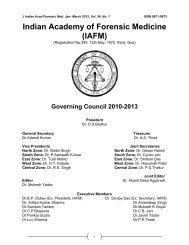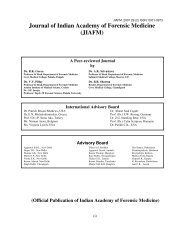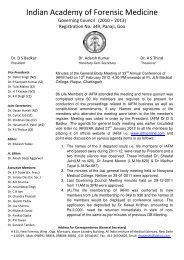Indian Academy of Forensic Medicine (IAFM) - Official website of IAFM
Indian Academy of Forensic Medicine (IAFM) - Official website of IAFM
Indian Academy of Forensic Medicine (IAFM) - Official website of IAFM
Create successful ePaper yourself
Turn your PDF publications into a flip-book with our unique Google optimized e-Paper software.
J <strong>Indian</strong> Acad <strong>Forensic</strong> Med. October- December 2011, Vol. 33, No. 4 ISSN 0971-0973<br />
Original Research Paper<br />
Effect <strong>of</strong> Ageing & Environmental Condition for Detection <strong>of</strong><br />
Blood Group from Blood Stain<br />
*Prakash M. Mohite, **Atul Keche, ***Anil J. Anjankar, ****Sudhir Ninave<br />
Abstract<br />
It is an established fact that laboratory investigations involving biological fluids play a vital role in<br />
crime investigations Blood as a source <strong>of</strong> evidence associated with crime, can provide valuable<br />
information that may solve the case. Proper collection, preservation and dispatch <strong>of</strong> this crucial evidence<br />
to the <strong>Forensic</strong> Science Laboratory is hence very essential. Improper collection and preservation can<br />
weaken or destroy a potential source <strong>of</strong> facts in a case. Many times the suspects may hide valuable blood<br />
stain evidence either on the object or the clothes in different conditions which may adversely affect the<br />
investigation. Hence, proper collection and preservation <strong>of</strong> blood stain is <strong>of</strong> paramount importance, as it<br />
may provide a strong link between an individual and a criminal act.<br />
The present study was undertaken to find out the maximum duration for which blood grouping is<br />
possible when the stains are exposed to varied environmental conditions.<br />
Key Words: Blood Stain, Evidence, Blood grouping, Crime scene.<br />
Introduction<br />
It is an established fact that laboratory<br />
investigations involving biological fluids play a<br />
vital role in crime investigations. It is useful<br />
scientific evidence as it forms an important link<br />
in chain <strong>of</strong> evidence or supports circumstantial<br />
evidence. [1]<br />
Edmond Locard (1877-1966), a lawyer<br />
and a physician, proposed that every criminal<br />
carries some elements with him/ her from the<br />
scene <strong>of</strong> crime by which he / she can be linked<br />
with the crime. Blood and Blood stains, likewise<br />
are a very important entity in medico legal<br />
practices, as factors like source <strong>of</strong> blood and<br />
their stains help in solving the crime <strong>of</strong> Violence,<br />
Sexual <strong>of</strong>fences , Vehicular accident cases,<br />
Disasters etc. [1] It helps to establish the relation<br />
between the <strong>of</strong>fence, <strong>of</strong>fender, the <strong>of</strong>fended and<br />
the <strong>of</strong>fending agent.<br />
A careful preservation <strong>of</strong> Blood samples<br />
and blood stain is therefore important. A careful<br />
laboratory investigation <strong>of</strong> Blood and Blood stain<br />
can yield information useful in the court <strong>of</strong> law<br />
with a varying degree <strong>of</strong> reliability. [2]<br />
Blood stains may be present on any<br />
material. Environmental changes affect its<br />
morphology & its contents.<br />
Corresponding Author:<br />
*Pr<strong>of</strong>essor, Department <strong>of</strong> <strong>Forensic</strong> <strong>Medicine</strong>,<br />
Jawaharlal Nehru Medical College, Sawangi (Meghe),<br />
Wardha (M.S) 442 004.<br />
** Assistant Pr<strong>of</strong>essor<br />
*** Pr<strong>of</strong>essor & Head<br />
**** Associate Pr<strong>of</strong>essor<br />
308<br />
Last but not the least the time lapse<br />
from its occurrence to its examination is also an<br />
important factor. Hence it was thought<br />
appropriate to take up the study to find out the<br />
effect <strong>of</strong> ageing and environmental factors on<br />
blood stains.<br />
Material & Methodology:<br />
This study was carried out in the<br />
Department <strong>of</strong> <strong>Forensic</strong> <strong>Medicine</strong> Jawaharlal<br />
Nehru Medical College, Sawangi (meghe)<br />
Wardha over a period <strong>of</strong> 3 years.<br />
For the study stains were prepared on<br />
different fabrics like Cotton cloth, terelene cloth<br />
and cotton gauze pieces <strong>of</strong> 2" x2" size. Known<br />
blood group samples were taken from the blood<br />
bank, Department <strong>of</strong> Pathology, where grouping<br />
<strong>of</strong> samples is done before transfusion. With the<br />
known blood group, stains were prepared by<br />
putting a drop <strong>of</strong> blood with the help <strong>of</strong> dropper<br />
over the cut pieces <strong>of</strong> fabrics with blood spread<br />
evenly on all parts <strong>of</strong> the fabric. The stains<br />
prepared were labeled (known group and with<br />
date on which it was prepared) and were<br />
subjected to different environmental conditions.<br />
Stains prepared on each fabric were<br />
equally divided and were kept in five different<br />
conditions. The stains, so prepared were stored<br />
in five (5) different conditions as under:<br />
1. Moist: Immediately wrapped in plain paper or<br />
kept in zip locked polythene bag.<br />
2. Semi moist: Stain was allowed to dry for 6-8<br />
hours at room temperature and then<br />
wrapped in plain paper or zip polythene bag.<br />
3. Dry: Stains were completely dried at room<br />
temperature under normal condition and









